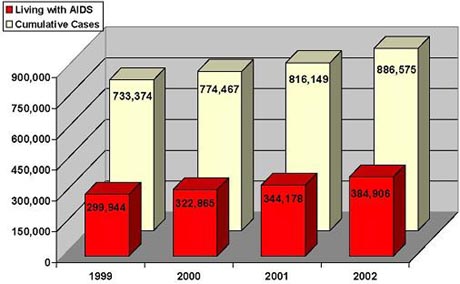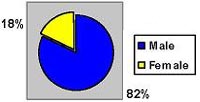The Government is Not Doing Enough
It was a miserable, cold morning on January, 15 2012 when my mother was taken away from me because she was infected with HIV AIDS. It is uncommon that you hear of someone affected by HIV AIDS compared to someone affected by cancer. AIDS is a chronic, potentially life-threatening condition caused by the human immunodeficiency virus (HIV). By damaging your immune system, HIV interferes with your body's ability to fight the organisms that cause diseases. HIV AIS can be transmitted through sexual intercourse, the sharing of needles, or the contact of body fluids. Not many people are aware that they may have this disease because it does not affect the victim until their last stages of death. HIV slowly took over my mother physical and mentally. Her appearance, self-esteem, and personality were completely destroyed.
Growing up, I faced many challenges that no child should experience because the absence of my mother. Because of this disease, she had an aneurism that caused her to be wheel chair bound and forced to stay in the hospital for the rest of her life span. I was ashamed to tell people who my mother was and that she was restricted to a wheel chair at a nursing home because the disease destroyed her system. Is the U.S. ashamed to admit that millions of men and women who die each year because they are suffering with HIV Aids or Aids? Children like me are also affected because of this horrifying disease. I know that I am not the only one in the world and there are kids that exist who are affected by HIV AIDS because their parents had it or are personally infected by the disease. As a result of my research, in order for the AIDS rate to decease the government needs to inform our citizens and support emotionally and financially.
The number of Americans being affected by AIDS is growing rapidly (see figure 1). The number of people living with HIV rose from around 8 million in 1990 to 34 million by the end of 2010(Avert). If more people are informed about AIDS, the less likely they are to be infected by it. I did a student survey of 27 students and I found that100% of students surveyed knows of someone who is affected by AIDS but none of them knew of the basic symptoms of AIDS or its symptoms. Of course, in order to promote AIDS, there has to be a government supported organization.
The lack of information also causes AIDS to be angled towards homosexuals. It is important for non-victims to be educated on how AIDS can be contracted. Government needs to take into consideration of the steps of promoting AIDS. Finding a specific way to promote AIDS is challenging. This is because AIDS is often target towards homosexual and bisexual males. According to statistics, homosexuals and bisexuals being targeted towards AIDS is stereotypical (see figure 3). AIDS being contracted by homosexuals has the same numbers in statics as AIDS being contracted by heterosexual activities (see figure 3). AIDS mainly exist among Caucasians, then African Americans and last Hispanics (see figure 2). Steps to promoting AIDS prevention is recognizing AIDS in the community, develop community approach, and eliminating discrimination. Some people affected with AIDS cannot receive treatment because they have not received any symptoms. Promotion on non-victims to get tested will help those who are unaware that they are affected by AIDS.
Supporting AIDS victims and non-victims emotionally can be done through the media. There is not enough media attention towards the disease which causes Americans to not realize that the disease is still in an epidemic phase. Supporting AIDS victims can be done through the media in various ways. One way is by commercial advertisement showing valuable information on how AIDS can be contracted, the symptoms, how to get tested, and why it is important to get tested. Another way is by movies, documentaries, and shows on television that is targeted towards teens and adults. Another way government can help supporting AIDS emotionally is by having health fairs in the community. Those health fairs can inform communities on everything they need to know about AIDS and also give them the chance to be tested.
The research and promotion for AIDS is being done by non-profit organizations that raise money to continue their journey of preventing AIDS without the help of the government. According to the “President’s Emergency Plan for AIDS Relief (PEPFRAR)”, George Bush created a plan for an organization that supports AIDS victims when he was in office. A current president, George W. Bush, announced the organization PEPFAR while given his State of the Union address, but there is no proof that this organization is still effective or ever was. George Bush informed Americans that there will be fifteen billion dollars going to an organization that will help the number of people affect by AIDS from increasing. The purpose of this plan is to stop seven million new AIDS infections and help treat two million people with lifesaving drugs and give care for the ten million people who are affected by AIDS. This plan also brings awareness to sex workers and inform them that they are more likely to contract this disease. Because of this, countries like Brazil do not support this plan. Unfortunately, this proposal is target towards homosexual men, drug abusers and also women.
The research and p“President’s Emergency Plan for AIDS Relief (PEPFRAR)”, romotion of AIDS needs a stable financial plan that will ensure AIDS victims and non-victims that they do have a caring support system and also tell non victims important information on AIDS. Also, AIDS need a government supported organization that do not target towards homosexuals men, drug abusers, and also women. Almost 149.8 billion dollars from the government is going to cancer research versus 15 billion that Bush promises towards AIDS research. That is a 134.8 billion dollar differences that needs to be fixed. If at least 100 billion dollars is towards AIDS and its research and promotion, then the number of victims affect by AIDS will decrease, but it cannot be done without the help of the government.
The government should be responsible for playing a part in promoting AIDS and the research behind it. If the government plays a role, then it will influence the community and other organization to come together to create possible solutions. A strong government founded organization is needed to decrease the number of Americans affected by AIDS. If the government supports AIDS informationally, emotionally, and financially then it gives non-victims a less likely advantage to created AIDS.
Important Charts and Graphs
Figure One
Figure Two
Estimated AIDS diagnoses in 2009 by race/ethnicity
Figure Three
Work Cited
47982 Duck News, November 1987, 7.83 Phil Dickie, The Road to Fitzgerald and Beyond
(Brisbane: University of Queensland Press, 1989),17_18.84 Under Section 208 of the
Queensland Criminal Code, it also still illegal for heterosexual couples to engage in anal intercourse. Robinson: Responding to Homophobia 197
AIDS Education and Prevention, 23(6), 479–494, 2011
© 2011 The Guilford Press
Afwerki, I. (1997). Foreign aid works best when it’s self limiting. Forum for Applied Research
and Public Policy, 12, 68-70.Bethel, E. R. (Ed.). (1995). AIDS: Readings on a global crisis. NeedhamHeights, MA: Allyn & Bacon. Thompson Jr. , Dennis. "Cancer Research: Where the Funding Goes ." Every Day Health I. Every Day Health Inc, 2012. Web. 9 May 2012. <http://www.everydayhealth.com/cancer/cancer-research-where-funding-goes.asp&xgt;.
Global Trends . 2012 . Photograph. Avert
"HIV and AIDS statistics by race/ethnicity." Internation Hiv and Aids Charity. Adverting Hiv
and Aids , 2011. Web. 14 Mar 2012. <http://www.avert.org/usa-race-age.htm>.
Moody, Jasmine. “AIDS Blog Survey.” Survey. 28 March 2012.








